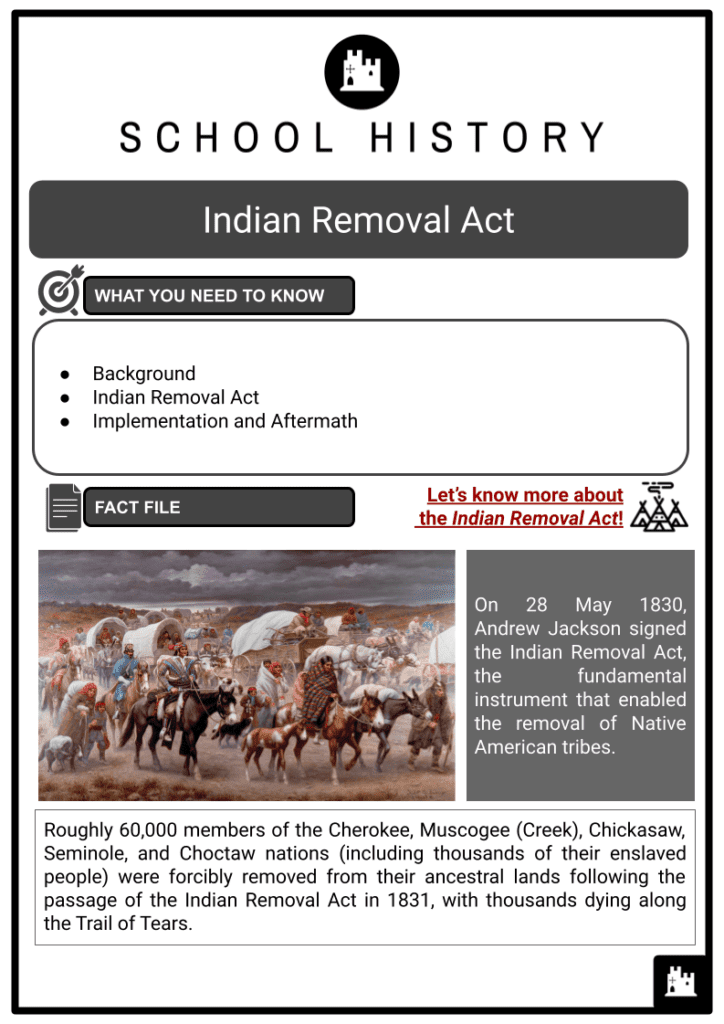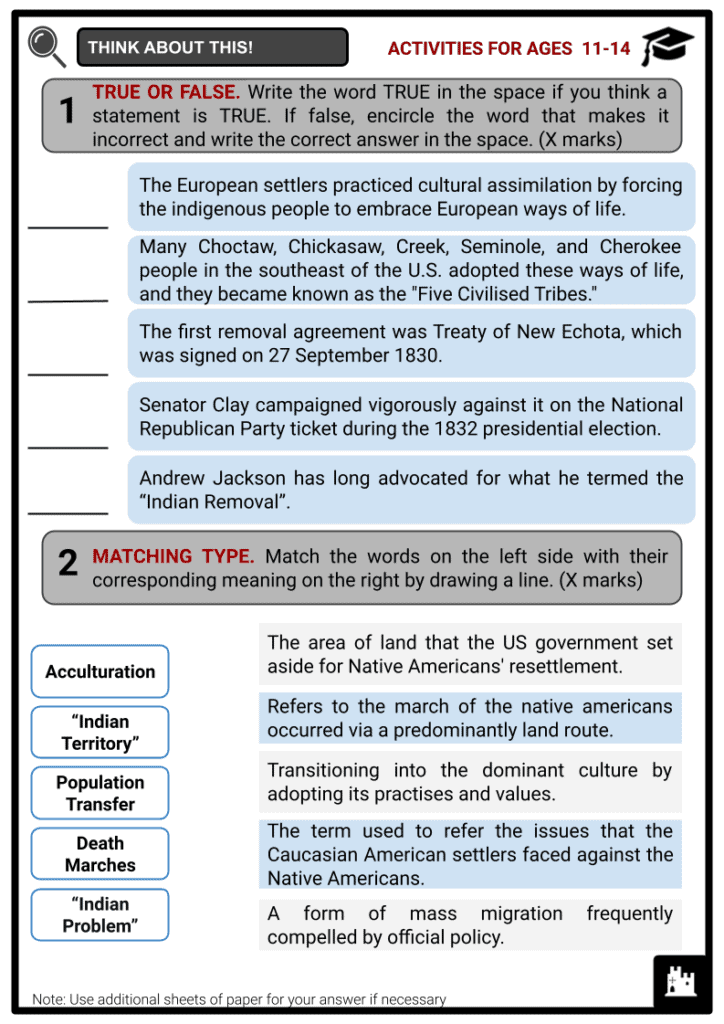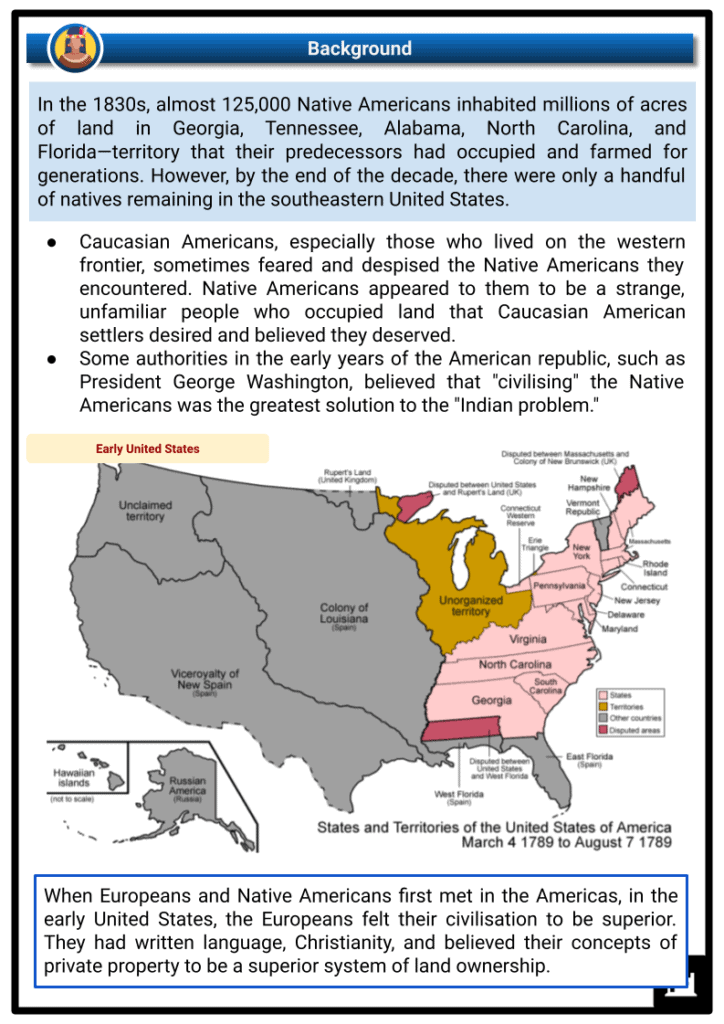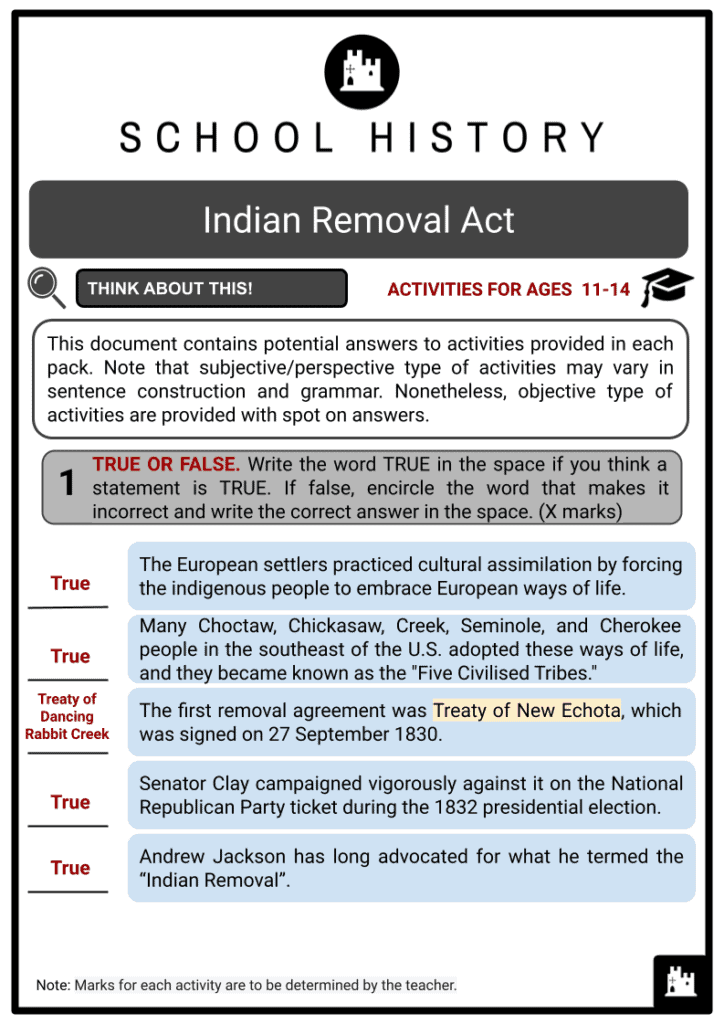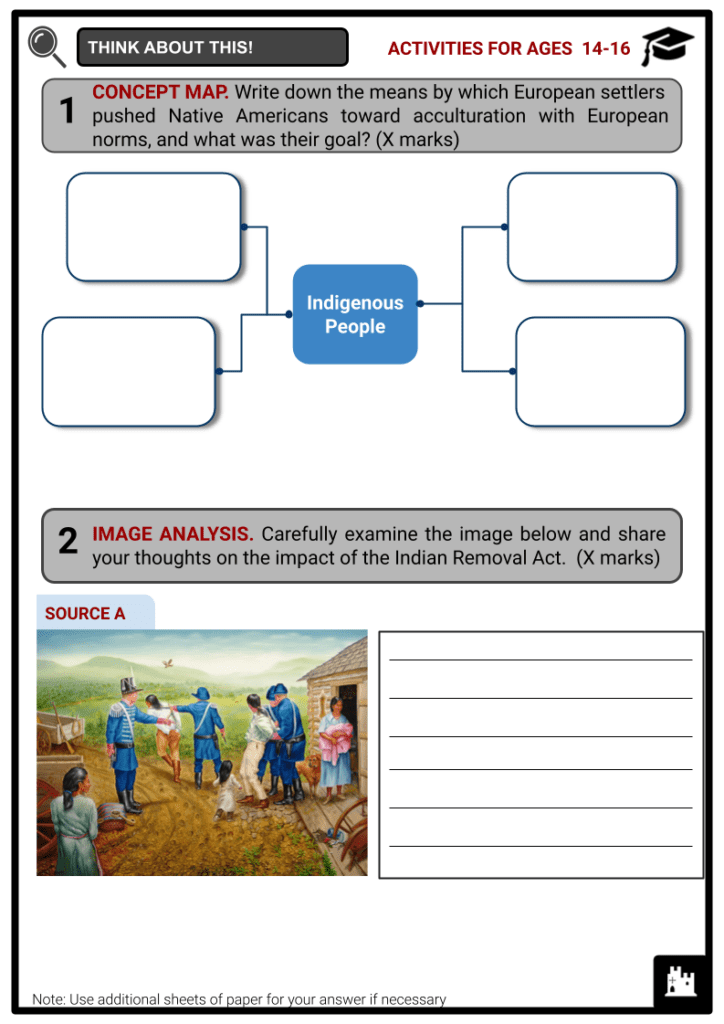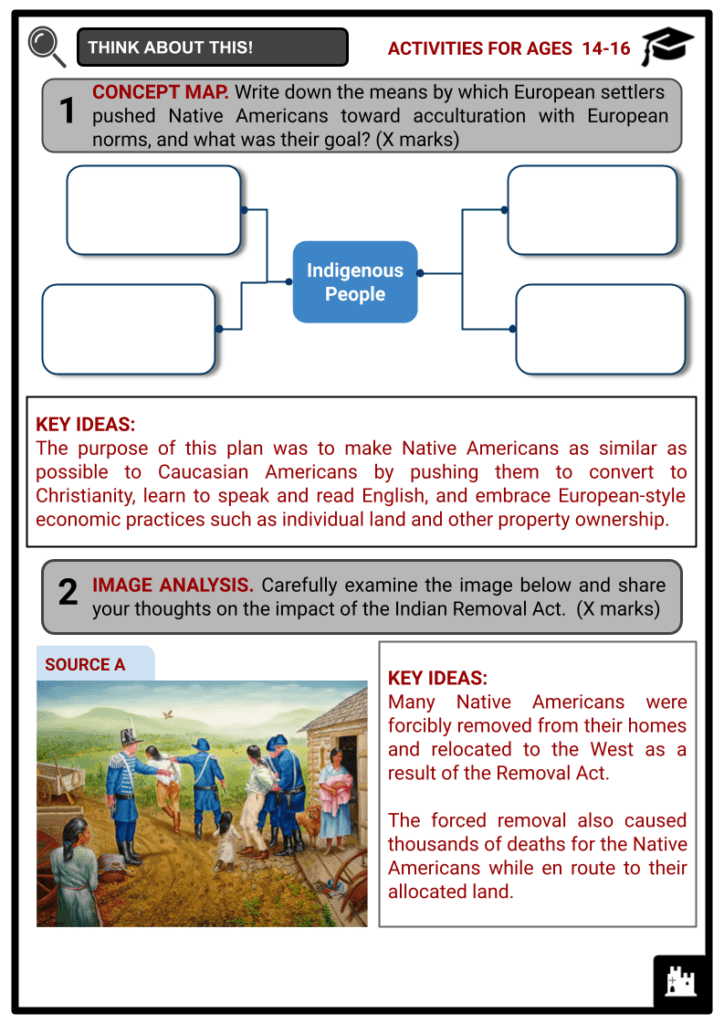Indian Removal Act Worksheets
Do you want to save dozens of hours in time? Get your evenings and weekends back? Be able to teach about the Indian Removal Act to your students?
Our worksheet bundle includes a fact file and printable worksheets and student activities. Perfect for both the classroom and homeschooling!
Summary
- Background
- Indian Removal Act
- Implementation and Aftermath
Key Facts And Information
Let’s know more about the Indian Removal Act!
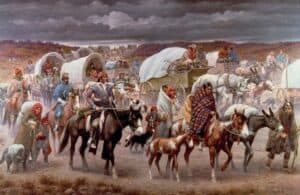 On 28 May 1830, Andrew Jackson signed the Indian Removal Act, the fundamental instrument that enabled the removal of Native American tribes. Roughly 60,000 members of the Cherokee, Muscogee (Creek), Chickasaw, Seminole, and Choctaw nations (including thousands of their enslaved people) were forcibly removed from their ancestral lands following the passage of the Indian Removal Act in 1831, with thousands dying along the Trail of Tears.
On 28 May 1830, Andrew Jackson signed the Indian Removal Act, the fundamental instrument that enabled the removal of Native American tribes. Roughly 60,000 members of the Cherokee, Muscogee (Creek), Chickasaw, Seminole, and Choctaw nations (including thousands of their enslaved people) were forcibly removed from their ancestral lands following the passage of the Indian Removal Act in 1831, with thousands dying along the Trail of Tears.
Background
- In the 1830s, almost 125,000 Native Americans inhabited millions of acres of land in Georgia, Tennessee, Alabama, North Carolina, and Florida—territory that their predecessors had occupied and farmed for generations. However, by the end of the decade, there were only a handful of natives remaining in the southeastern United States.
- Caucasian Americans, especially those who lived on the western frontier, sometimes feared and despised the Native Americans they encountered. Native Americans appeared to them to be a strange, unfamiliar people who occupied land that Caucasian American settlers desired and believed they deserved.
- Some authorities in the early years of the American republic, such as President George Washington, believed that "civilising" the Native Americans was the greatest solution to the "Indian problem."
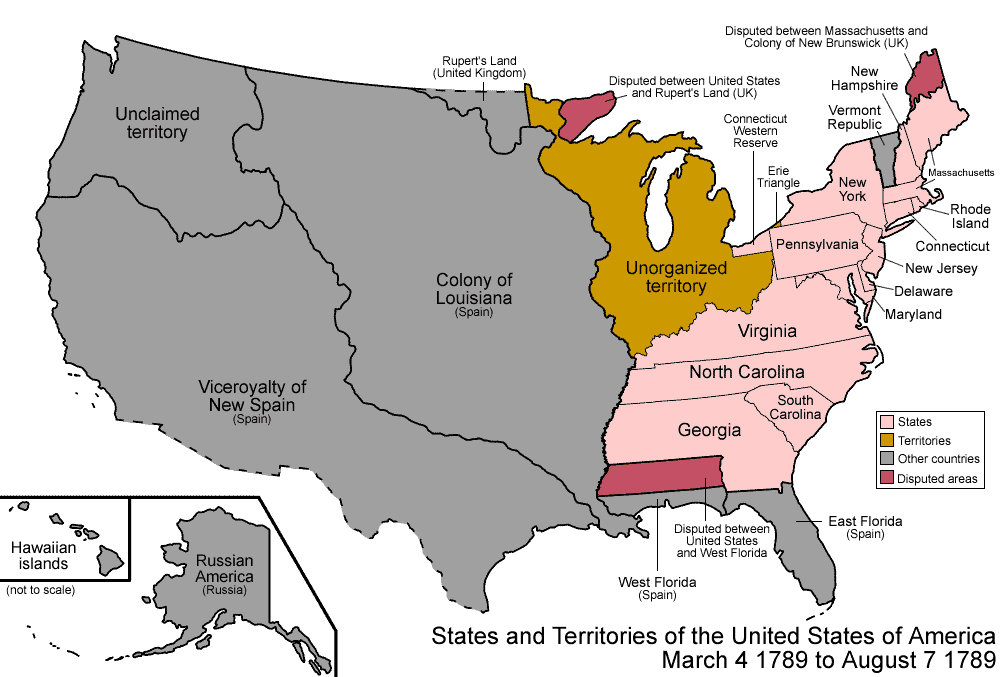
Acculturation
- The European settlers practiced cultural assimilation by forcing the indigenous people to embrace European ways of life.
- When people of one culture are exposed to another culture (host) that is predominately more prevalent in their region of residence, it is possible that some characteristics of the host culture will be adopted and incorporated into the original culture of the individuals. In continuous interaction, cultures have shared and exchanged foods, music, dances, clothing, tools, and technologies.
- This acculturation was first proposed by George Washington and was well underway among the Cherokee and Choctaw by the start of the nineteenth century.
- The indigenous population was encouraged to adopt European customs. They were initially compelled to convert to Christianity and cease pagan traditions.
- Although there was interest in developing a writing and printing system for a few Native languages, particularly Cherokee, as demonstrated by Sequoyah's Cherokee syllabary, they also had to learn to speak and read English.
- Native Americans were also encouraged to adopt monogamous heterosexual marriages.
- Moreover, Native Americans had to recognise the concept of private land and property ownership, including, in some instances, enslaved Africans.
- Many Choctaw, Chickasaw, Creek, Seminole, and Cherokee people in the southeast of the U.S. adopted these ways of life, and they became known as the "Five Civilised Tribes."
- In areas of Georgia, North Carolina, Alabama, Florida, and Tennessee, Native American land was valuable, and its demand increased as European settlers flooded the region.
- Many of these Europeans aspired to amass wealth by cultivating cotton and frequently resorted to violence to acquire land from their Indigenous neighbours. They stole animals, destroyed and pillaged houses and towns, committed mass murder, and occupied unclaimed property.
- The government of the United States initiated a systematic removal of Native American tribes from the Southeast. In the southeastern United States, the Chickasaw, Choctaw, Muscogee-Creek, Seminole, and ancient Cherokee tribes had been created as autonomous nations (independent or self-governing community).
Indian Removal Act
- Andrew Jackson has long advocated for what he termed the "Indian Removal." As an Army general, he had led violent battles against the Creeks in Georgia and Alabama and the Seminoles in Florida, resulting in the transfer of hundreds of thousands of acres of property from Native Americans to Caucasian American farmers.
- When Jackson became the president of the United States in 1829, he took a hard stance on “Indian removal”. Jackson renounced his predecessors' practice of treating Native American tribes as independent nations and actively pursued any Native Americans east of the Mississippi who asserted constitutional sovereignty and independence from state laws.
- Georgia, the largest state in 1802 and a state embroiled in a conflict over jurisdiction with the Cherokee, was a firm supporter of the Removal Act and one of its strongest supporters. The Georgia situation, in Jackson's view, would be resolved through “Indian Removal”.
- The Indian Removal Act was particularly controversial. Many Caucasian Americans supported its passage at the time, but there was also considerable resistance. Many Christian missionaries, including missionary organiser Jeremiah Evarts, protested against it. Senator Theodore Frelinghuysen of New Jersey, Senator Henry Clay of Kentucky, and Representative Davy Crockett of Tennessee opposed the
Act in Congress.
Discussion
- The Removal Act was passed only after a heated congressional debate.
- Senator Clay campaigned vigorously against it on the National Republican Party ticket during the 1832 presidential election.
- Jackson believed that the extinction of Indigenous countries was inevitable, citing the spread of settled life and the decline of tribal nations in the northeastern United States.
- Given the Northerners' treatment of indigenous people in the past, he criticised them for being hypocrites. According to Jackson, "development requires forward movement."
- According to historian H. W. Brands, Jackson truly believed that his population transfer was a "wise and compassionate strategy" that would prevent the "total destruction" of Native Americans. Jackson portrayed the removal as a merciful act of compassion.
Vote
- The Senate enacted the Indian Removal Act by a vote of 28 to 19 on 24 April 1830.
- The Act was approved by a vote of 101 to 97 in the House of Representatives on 26 May 1830.
- President Andrew Jackson approved and signed the Indian Removal Act into law on 28 May 1830.
- Jackson granted the federal government the authority to trade Native-held territory in the cotton kingdom east of the Mississippi for land to the west, in the "Indian colonisation zone" acquired as part of the Louisiana Purchase.
Implementation and Aftermath
- The Indian Removal Act, which carried out federal policy regarding its Indigenous inhabitants, caused Native American tribes who lived east of the Mississippi to be relocated to areas west of the river.
- The act gave the president the power to set up land exchange agreements, but it did not legalise the forced removal of indigenous tribes.
Choctaws
- The first removal agreement was The Treaty of Dancing Rabbit Creek, which was signed on 27 September 1830. Choctaws in Mississippi renounced land east of the river in exchange for payment and land in the west.
- A tribal leader described the tribe's journey to Little Rock as a “Trail of Tears”.
- The relocated Native Americans endured exposure, sickness, and famine while travelling to their newly allocated “Indian reservation”. Thousands perished from disease before or shortly after reaching their destinations.
Cherokee
- While the Indian Removal Act allowed for the voluntary relocation of tribes, it was frequently exploited by government agents. The most notable instance is the Treaty of New Echota, which a small group of twenty individuals signed.
- On 29 December 1835, Cherokee tribe people (not the tribal leadership) were there. Most Cherokees later blamed the group and the pact for the 1838 displacement of their tribe.
- Approximately 4,000 Cherokee died during the Trail of Tears march. Jeremiah Evarts, a missionary organiser, persuaded the Cherokee Nation to take its case to the U.S. Supreme Court.
- In Cherokee Nation v. Georgia (1831), the Marshall court heard the case but declined to rule on its merits, ruling that Native American tribes were not sovereign nations and hence could not "maintain an action" in U.S. courts.
- Chief Justice Marshall wrote in Worcester v. Georgia (1832) that individual states lacked power over Native American affairs.
- The state of Georgia disregarded the Supreme Court's decision, and the desire of settlers and land speculators for Native American lands persisted unabated; some Caucasian Americans felt that Native Americans were a threat to peace and security.
- The Georgia legislature established a legislation prohibiting settlers from staying on Native American land after 31 March 1831, without a state licence; missionaries opposed to Native American removal were excluded.
Seminole
- In 1835, the Seminole refused to leave their land in Florida, resulting in the Second Seminole War. Along with fleeing enslaved people, the Seminoles and other tribes did not go peacefully and fought the removal.
- The Second Seminole War (1835-1842) culminated in the government permitting the Seminoles to remain in the wetlands of south Florida. Few remained, and around 3,000 were eliminated throughout the war.
Muskogee (Creek)
- After the Fort Jackson and Washington treaties, the Muscogee were forced to relocate to a small area in what is now central Alabama's eastern corner. With the signing of the Treaty of Cusseta in 1832, the national council of the Creek Native Americans ceded their remaining territories east of the Mississippi to the United States and agreed to be relocated to the “Indian Territory”.
- During the Trail of Tears in 1834, the majority of the Muscogee were forcibly relocated to Oklahoma.
- The Creek War of 1836 put an end to the federal government's efforts to persuade the Creek people to willingly relocate, but peaceful Creeks were not forcibly relocated west. The Creek people were rounded up, herded into camps, and told they would be moving soon.
- Five detachments of the 16,000 Creeks were created and despatched to Fort Gibson. The Creek leaders made every effort to negotiate better conditions, and they were successful in acquiring waggons and medicine.
- To prepare for the move, Creeks began to deconstruct their spiritual life; they burned mounds of lightwood over the graves of their ancestors to commemorate their memories and polished the sacred plates that would travel at the front of each group. Additionally, they prepared monetarily by selling what they could not bring.
- In September 1836, amid hard weather, the detachments resumed their march west. In spite of their preparations, the detachments encountered poor roads, inclement weather, and a scarcity of potable water. When all five detachments arrived at their location, the death toll was tallied.
- The first detachment of 2,318 Creeks suffered 78 deaths, while the second detachment of 3,095 Creeks suffered 37 deaths. The fourth had 2,330 Creeks and 36 deaths, while the fifth had 2,818 Creeks and 12 deaths. The fifth detachment of 2,087 Creeks suffered 25 fatalities.
Chickasaw
- The Chickasaw were to receive $3 million in cash from the United States in exchange for their land property east of the Mississippi River, in contrast to other tribes that exchanged land.
- After five years of heated argument, in 1836, the Chocktaw and the settlers finally settled on a price for the westernmost Choctaw land: $530,000.
- The majority of Chickasaw people relocated between 1837 and 1838. For nearly 30 years, the United States failed to pay the Chickasaw the $3 million they were owed.
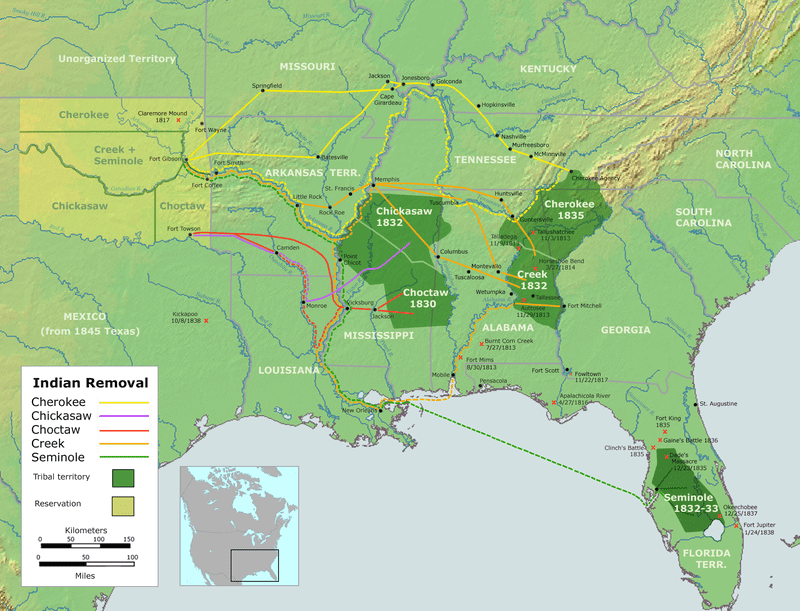
A representation of the Indian Removal Process
Aftermath
- The Five Civilised Tribes were sent to the newly established “Indian Territory”. The Cherokee occupied the northeast corner of the territory and a 70-mile-wide (110-kilometer-wide) strip of Kansas along the territory's boundary.
- Some indigenous peoples resisted the forced migration more vehemently than others. The few that remained established tribal groups, such as the Eastern Band of Cherokee (headquartered in North Carolina), the Mississippi Band of Choctaw Native Americans, the Seminole Tribe of Florida, and the Creeks of Alabama (including the Poarch Band).

